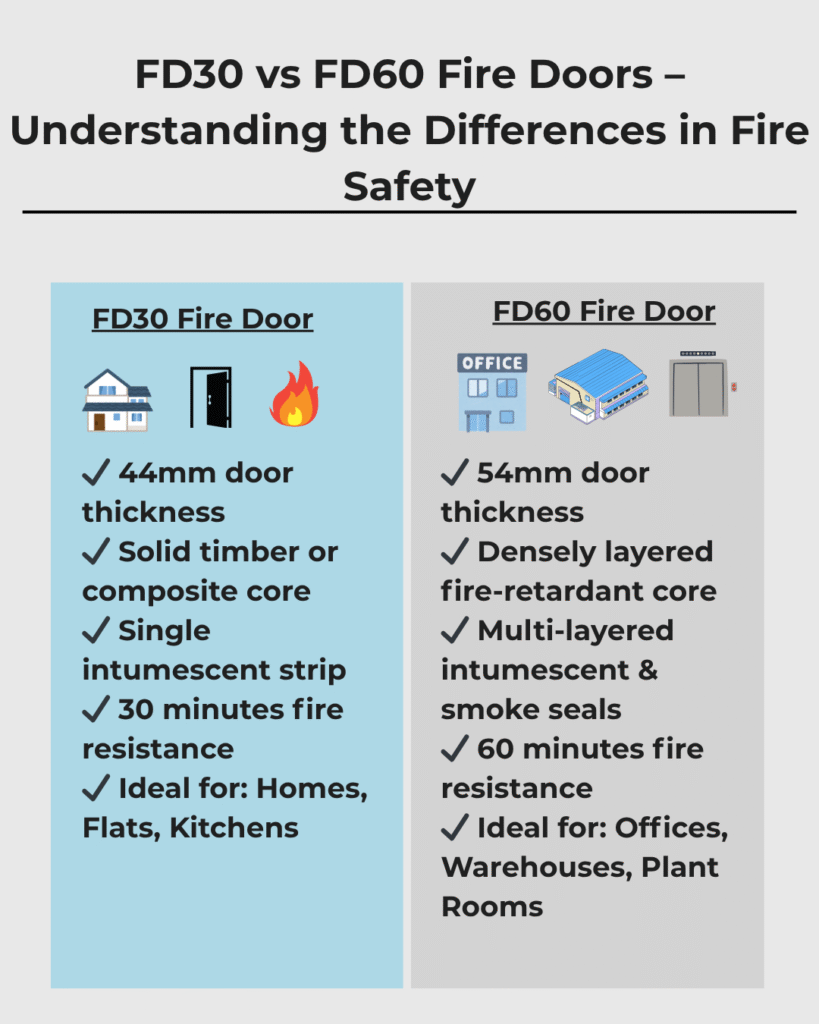Discover what a fire door is, explore FD30, FD60, glazed, and solid core fire door types, and learn how each contributes to fire safety in residential, commercial, and industrial buildings. When it comes to protecting lives and property from fire, fire doors play a silent but vital role. These specially constructed doors are designed to slow the spread of fire and smoke, buying valuable time for evacuation and emergency response. Whether in homes, offices, or factories, fire doors are an essential component of building safety regulations.
When it comes to passive fire protection, fire doors are one of the most critical components. These specially designed doors are built not only to contain fire but to give occupants time to safely evacuate a building.
At Noviak Construction, based in Richmond, London, we specialise in installing and maintaining high-performance fire doors for residential, commercial, and industrial properties. In this article, we’ll explore:
A fire door is a specialist door set—including the door, frame, seals, and hardware—engineered to withstand fire for a set period of time, usually 30 or 60 minutes. Unlike standard doors, fire doors are built with fire-resistant materials and intumescent seals that expand when exposed to heat, sealing gaps and preventing smoke from escaping.
A correctly installed and maintained fire door is a legal requirement in many types of buildings under UK fire safety regulations.
Fire doors are given ratings based on how long they can resist fire:
FD30 Fire Doors – 30 Minutes Fire Resistance
Glazed fire doors contain fire-rated glass panels that allow light and visibility without compromising fire protection. These are especially popular in:

Absolutely. Fire-rated glass can resist intense heat for 30, 60, or even 120 minutes, depending on its type. It won’t shatter or explode under thermal stress like ordinary glass.
Usage Tip: Always ensure that glazing beads and intumescent seals are properly fitted and tested as a whole unit.
Solid core fire doors are constructed using high-density materials like:
They form the backbone of most FD-rated doors, especially where glazing is not required. These doors are:
Each fire door type has its specific application. Here’s a breakdown by building type:
Fire doors aren’t just about slowing fire—they’re about saving lives. Here’s how:
Installing a certified fire door is not just about the door itself. It’s about the entire door set, which includes:
Poor installation can invalidate the fire certification. That’s why our team at Noviak Construction ensures:
Annual inspections are legally required in many commercial settings. We also offer fire door inspection and maintenance services across Richmond, Twickenham, Kingston, and Greater London.
Are fire doors mandatory in UK homes?
Yes, especially in HMOs, flats, and homes with internal garages or loft conversions. FD30 doors are usually required to separate risk areas.
Can I paint a fire door?
Yes, but only using fire-retardant paint and without altering seals or ironmongery.
How do I know if my fire door is compliant?
Look for:
Better yet—book a professional inspection with Noviak Construction.
Conclusion: Invest in Safety with Certified Fire Doors
Fire doors are a crucial line of defense in any fire safety strategy. Whether you’re a homeowner, property manager, or commercial building owner, fire doors are essential for life safety and regulatory compliance.
At Noviak Construction, our expert team delivers certified fire door installation, inspections, and maintenance services throughout Richmond and Greater London. We help you choose the right fire doors — FD30, FD60, glazed, or solid core — to suit your property type and fire strategy.
Need expert advice or a site survey?
👉Contact Noviak Construction today for a free consultation.